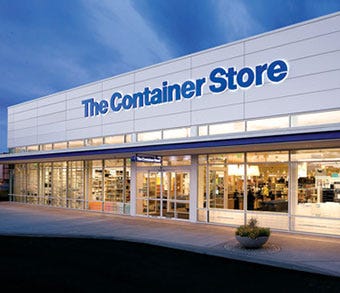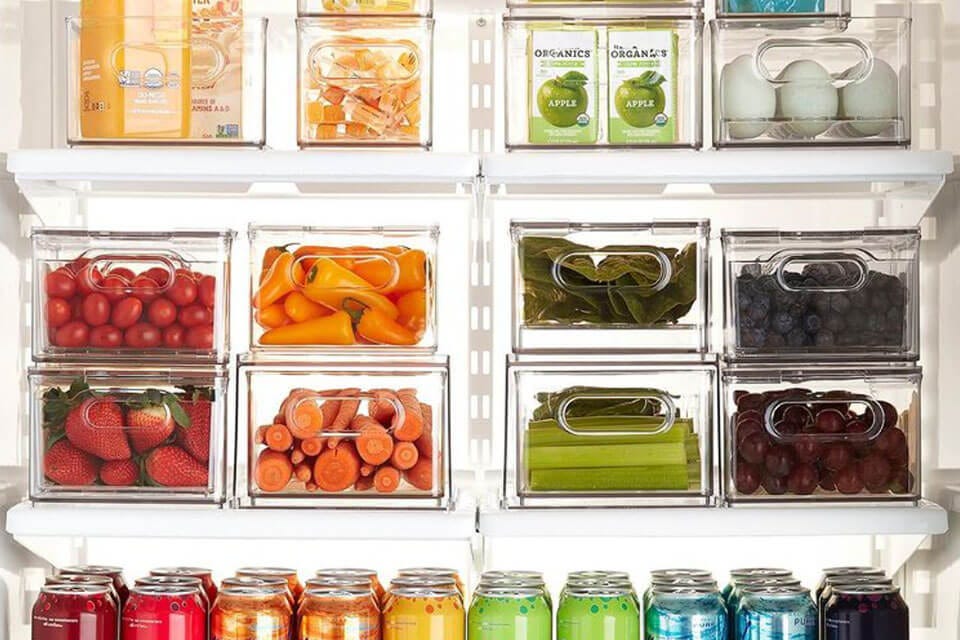Grab Bag: Seeking Control in the Container Store
What our desire for empty boxes tells us about ourselves
Every once in a while I resuscitate an old article or essay I wrote as a freelancer and republish it under the Grab Bag section of my Substack. (If this section had a tagline, it would be “Stick your hand in and see what you get!” Which I realize might produce strange mental images, especially given that my last one was about chickens, but work with me.) The point is to share writing that I find interesting or quirky or fun, in hopes that it might give you something more satisfying to do when you have five spare minutes than doomscrolling on your phone. They’re not tied to the news at all, which is also part of the point.
Today’s piece is about my experience discovering The Container Store shortly after college (yes, this is about 20 years old). I chose it for today because in my last post — about how to have a good weekend — I referred to organizational expert Julie Morgenstern, and then remembered that her book, Organizing from the Inside Out, actually inspired me to write this essay.
If this piece does have any kind of meta message, it’s that it represents something that personally makes me feel more alive: finding metaphorical significance (and humor) in otherwise mundane experiences. Enjoy, keep sharing your daily delights, and I’ll see you next week.
Rain pelted down on 18th Street when my friend Sarah and I arrived at The Container Store, armed with lists and measurements in simultaneous quests to organize our lives. Sarah was searching for structure within her sock drawer. I was on a mission to purge my desk, control my clothing and color-code my craft supplies. Together we walked through sliding glass doors onto an oversized welcome mat. “Contain Yourself,” it said in tall, thin letters. We made no such promises.
Started in 1978 in Dallas, Texas by Kip Tindell and Garrett Boone, The Container Store has long been embraced as a pilgrimage-worthy destination for anyone squeezed into a studio apartment, and Sarah and I were eager to visit what was then (and is still) the only Container Store in Manhattan. (Ironically, it took over twenty five years for The Container Store to get to New York City to begin with because, with an average store size of 25,000 square feet, it was hard to find the space.)
As the doors slid shut behind us, Sarah grabbed a shopping cart and steered confidently toward Closet Accessories. Alone, I started down a different aisle and descended into a spiral of self-doubt upon discovering storage solutions for problems I didn’t know I had. I work out and I wear clothes—so how had I survived for so long without a stainless steel gym basket? How had I ever given people presents without a gift wrap organizing set? Could I ever truly consider myself festive if I didn’t own a storage bag for an artificial Christmas tree?
Of course, in terms of messiness, I could have been worse. But still, I hated my filing cabinet, my messy desk, my illogical system for underwear storage. That’s why I’d been so excited when Sarah lent me Julie Morgenstern’s best-selling book, Organizing From the Inside Out. In it, “America’s #1 Organizer” promises that she’ll help “break through the clutter and streamline your life . . . with a unique organizing plan based on your individual goals, natural habits, and psychological needs.” Becoming organized, she proclaims, will “set you free to live the life you dream about.”
I curled up in bed eager to learn how alphabetization could lead to emotional fulfillment. In Chapter Two, titled “What’s Holding You Back?” I took Julie’s three-level diagnostic test examining the causes of my clutter and decided I was suffering from “Technical Errors.” Excellent. Unlike “External Realities” and “Psychological Impediments to Organization,” this was the only cause of messiness that did not require therapy.
With that figured out, I told myself, getting organized should be as easy as 1-2-3. Or, as Julie put it, S-P-A-C-E.
“Sort, Purge, Assign, Containerize, Equalize!” I repeated to myself as I stood in my room surrounded by piles of old clothing, trying to internalize the idea that throwing out a pair of ancient running shoes would not mean losing a piece of myself. I set aside three large bags of clothing for Goodwill and attacked my file cabinet, still wearing two shirts, pants, a skirt, and mismatched shoes left over from reevaluating my wardrobe. Three hours later I emerged triumphant at “C”: Containerize. It was now time to follow my dreams.
But can dreams fit inside plastic boxes? According to my pre-Container Store research, at least one other person thought so. A book called Tupperware: The Promise of Plastic in America revealed that Earl Silas Tupper was an inventor who “envisioned a world utterly transformed through the appropriate application of polyethylene.” It describes Tupper as a “visionary man” who believed that “his refrigerator dishes were . . . destined to change the lives of American citizens” and who demonstrated a “persistent striving toward self-betterment.”
Now, decades after its creator’s birth, I stood in the Tupperware aisle and questioned how I had fed myself for so many years without a resealable sandwich box. Self-betterment, it seemed, came in many stay-tight plastic packages; my problem was that I wanted them all.
Why is this completely unrealistic and impractical image of a color-coded refrigerator so viscerally appealing? (Also: is that a drawer reserved exclusively for grape tomatoes?)
Carrying a Zen shower tote as a makeshift shopping basket, I clutched my list in my fist like a security blanket and approached a display of plastic nesting boxes, the smallest of which could barely hold a penny. They were the epitome of useless. But, with that said, they came in candy colors. Hadn’t Julie claimed that staying organizationally motivated required a touch of fun? I had just mentally reconfigured a grass-green sugar cube-sized box into a joyous, and thus essential, representation of my childhood when Sarah grabbed my arm.
“Those aren’t on your list,” she said.
“But they’re my childhood,” I whimpered as she took away my basket and disappeared into Office Supplies. I felt lost, confused, abandoned.
“Excuse me, would you like to see a demonstration of stackable drawers made by Elfa, our in-house brand?” I whirled around to find a chirpy red-haired sales associate behind me with a smile on her face and “Tracy” on her name tag. “You can custom design a set to help you meet your storage needs.”
“Uh, sure,” I said. “But I don’t really know what I’m looking for.”
Not only was that true in a more general sense, but it also was a violation of Container Store Rule # 1: Never show weakness. At first I was content to listen—after all, Tracy knew what she was talking about when it came to stackable storage. But five minutes of hearing Tracy bubble on about shoe trees made me wonder what her apartment looked like, especially after a 40% employee discount, and as I listened, I began to hate Tracy and her storage solutions. I hated her cheery smile and her stupid “Contain Yourself” blue apron. I could never live like that and, you know what? I wouldn’t want to.
Tracy hadn’t expected me to walk away from her mid-sentence but I thought she deserved it. “Wait, are you sure?” she called, but I refused to look back, instead ducking into the desk supply aisle where I found Sarah slumped in a chair next to mesh wire letter sorters.
“I can’t help it,” she said, looking at an archival photo storage box I had found that was both functional and purple. “I feel organizationally competitive with you.”
Again with the rainbows.
The thing is, The Container Store was a force bigger than she or I had realized. Our fellow customers might think they were looking for effective kitchen recycling centers, but I saw them searching for control in the rest of their lives. Just mentioning the Container Store’s name can make a look of panic flash across the face of anyone whose take-out menus aren’t cross-indexed. “I should really go there,” said a usually secure friend of mine, speaking in the same tone one might use to admit to liking Nickelback. “My room’s a mess.”
When Sarah and I walked out of the store two hours later, I noticed that my bags, while large, were surprisingly light. The metaphorical significance of this hit me later that night when I sat in my room surrounded by chaotic piles of organizational materials. By buying containers, I decided, I was not only asserting control over my past and present life; I was investing in my future—each box, each bag, seemed to burst with possibility. It was enough to make me think that if I just had the right storage units, missing areas of my life would fill themselves in; too bad the Container Store didn’t have any boxes labeled “A Sense of Belonging and Community,” “Lasting Financial Security,” or “Friends Who Are Available to Hang Out on Weeknights.”
By one that morning, my underwear were separate from my socks, my workout clothes sat neatly folded in their new stainless steel gym basket and I was nearing the end of Julie’s five-step process. But something still seemed to be missing. Could it be my shower tote? I picked up my receipt and found the answer staring back at me from the bottom line. My discontent had nothing to do with polyethylene. I had just spent $200 on empty boxes.
To scrolling less, living more, and only buying boxes if you need them,
Author of How to Break Up With Your Phone and The Power of Fun: How to Feel Alive Again







